YAMAHA XMAX 300 2018 User Guide
Manufacturer: YAMAHA, Model Year: 2018, Model line: XMAX 300, Model: YAMAHA XMAX 300 2018Pages: 116, PDF Size: 7.14 MB
Page 11 of 116

Safety information
1-5
1 Aftermarket Tires and Rims
The tires and rims that came with your
scooter were designed to match the
performance capabilities and to pro-
vide the best combination of handling,
braking, and comfort. Other tires, rims,
sizes, and combinations may not be
appropriate. Refer to page 7-19 for tire
specifications and more information on
replacing your tires.
Transporting the Scooter
Be sure to observe following instruc-
tions before transporting the scooter in
another vehicle.
Remove all loose items from the
scooter.
Point the front wheel straight
ahead on the trailer or in the truck
bed, and choke it in a rail to pre-
vent movement.
Secure the scooter with tie-downs
or suitable straps that are at-
tached to solid parts of the scoot-
er, such as the frame or upper
front fork triple clamp (and not, for
example, to rubber-mounted han-
dlebars or turn signals, or parts
that could break). Choose the lo-
cation for the straps carefully so
the straps will not rub against
painted surfaces during transport.
The suspension should be com-
pressed somewhat by the tie-
downs, if possible, so that the
scooter will not bounce exces-
sively during transport.
EAU57600
Further safe-riding points
Be sure to signal clearly when
making turns.
Braking can be extremely difficult
on a wet road. Avoid hard braking,
because the scooter could slide.
Apply the brakes slowly when
stopping on a wet surface.
Slow down as you approach a
corner or turn. Once you have
completed a turn, accelerate
slowly.
Be careful when passing parked
cars. A driver might not see you
and open a door in your path.
Railroad crossings, streetcar rails,
iron plates on road construction
sites, and manhole covers be-
come extremely slippery when
wet. Slow down and cross them
with caution. Keep the scooter up-
right, otherwise it could slide out
from under you.
The brake pads or linings could
get wet when you wash the scoot-
er. After washing the scooter,
check the brakes before riding.
Always wear a helmet, gloves,
trousers (tapered around the cuff
and ankle so they do not flap), and
a brightly colored jacket.
Do not carry too much luggage on
the scooter. An overloaded scoot-
er is unstable. Use a strong cord
to secure any luggage to the carri-
er (if equipped). A loose load will
affect the stability of the scooter
and could divert your attention
from the road. (See page 1-3.)
UBY3E0E0.book Page 5 Friday, September 15, 2017 3:59 PM
Page 12 of 116
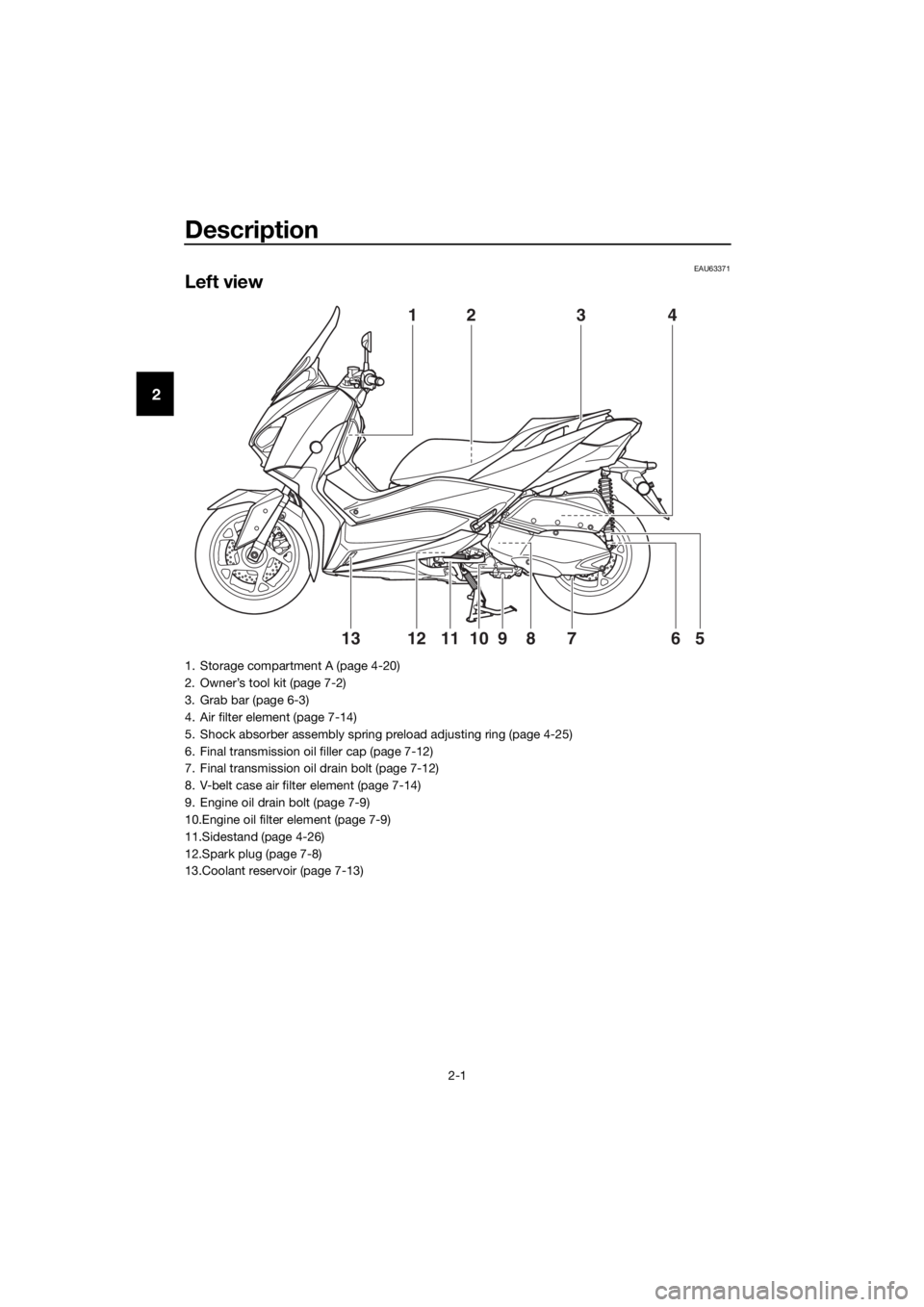
Description
2-1
2
EAU63371
Left view
41
5610812791113
23
1. Storage compartment A (page 4-20)
2. Owner’s tool kit (page 7-2)
3. Grab bar (page 6-3)
4. Air filter element (page 7-14)
5. Shock absorber assembly spring preload adjusting ring (page 4-25)
6. Final transmission oil filler cap (page 7-12)
7. Final transmission oil drain bolt (page 7-12)
8. V-belt case air filter element (page 7-14)
9. Engine oil drain bolt (page 7-9)
10.Engine oil filter element (page 7-9)
11.Sidestand (page 4-26)
12.Spark plug (page 7-8)
13.Coolant reservoir (page 7-13)
UBY3E0E0.book Page 1 Friday, September 15, 2017 3:59 PM
Page 13 of 116
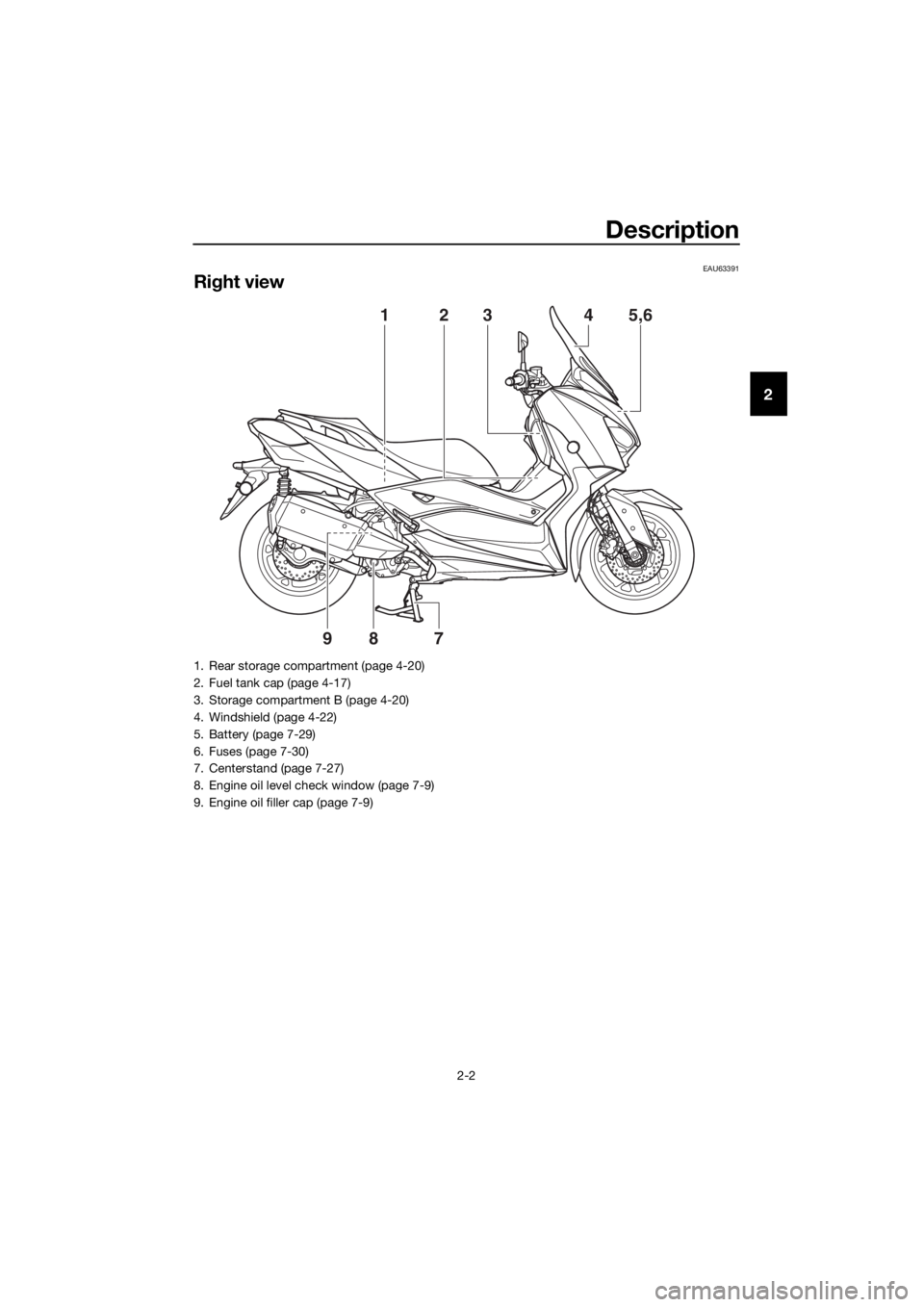
Description
2-2
2
EAU63391
Right view
2345,61
987
1. Rear storage compartment (page 4-20)
2. Fuel tank cap (page 4-17)
3. Storage compartment B (page 4-20)
4. Windshield (page 4-22)
5. Battery (page 7-29)
6. Fuses (page 7-30)
7. Centerstand (page 7-27)
8. Engine oil level check window (page 7-9)
9. Engine oil filler cap (page 7-9)
UBY3E0E0.book Page 2 Friday, September 15, 2017 3:59 PM
Page 14 of 116
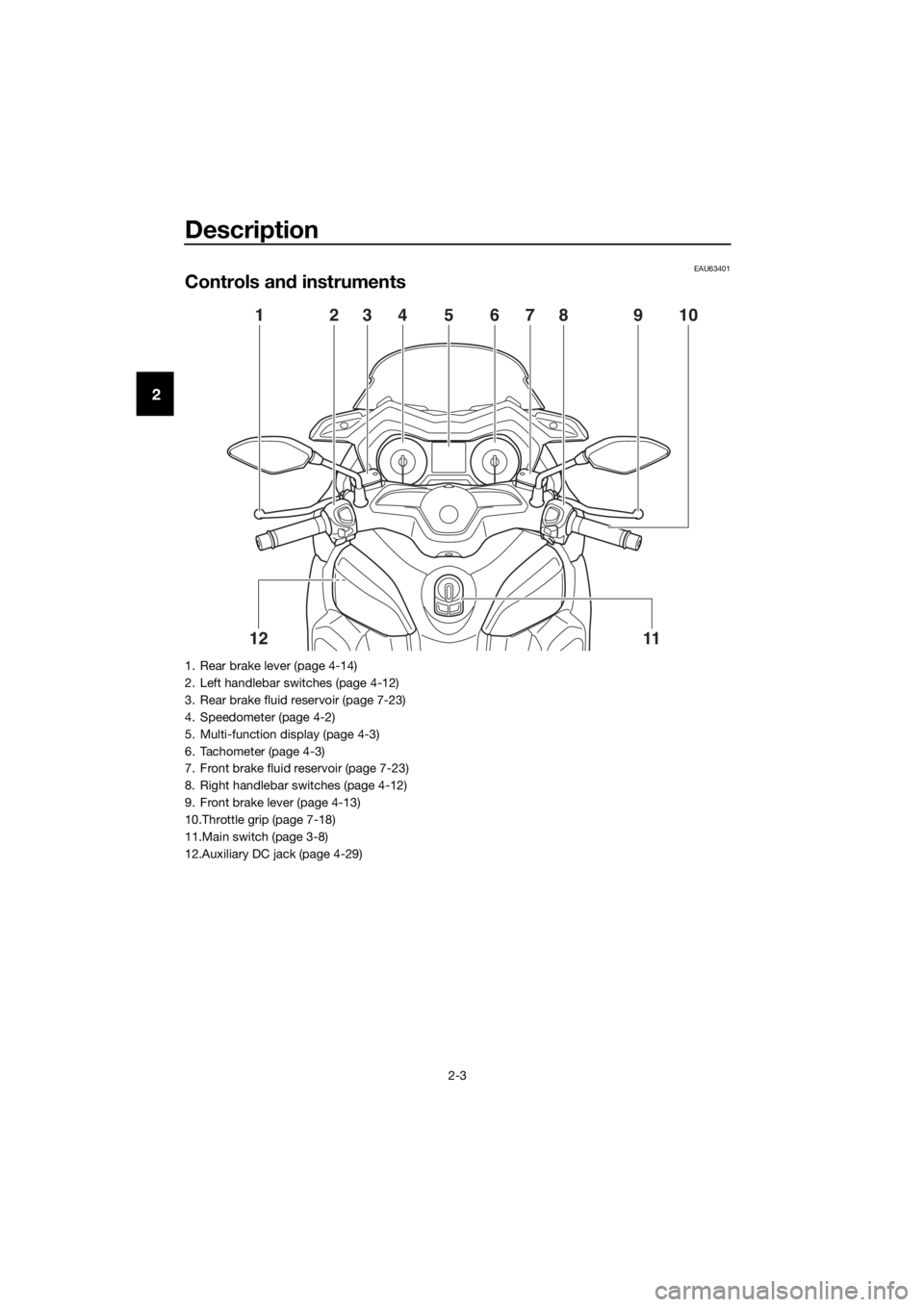
Description
2-3
2
EAU63401
Controls and instruments
10
1112
123987564
1. Rear brake lever (page 4-14)
2. Left handlebar switches (page 4-12)
3. Rear brake fluid reservoir (page 7-23)
4. Speedometer (page 4-2)
5. Multi-function display (page 4-3)
6. Tachometer (page 4-3)
7. Front brake fluid reservoir (page 7-23)
8. Right handlebar switches (page 4-12)
9. Front brake lever (page 4-13)
10.Throttle grip (page 7-18)
11.Main switch (page 3-8)
12.Auxiliary DC jack (page 4-29)
UBY3E0E0.book Page 3 Friday, September 15, 2017 3:59 PM
Page 15 of 116
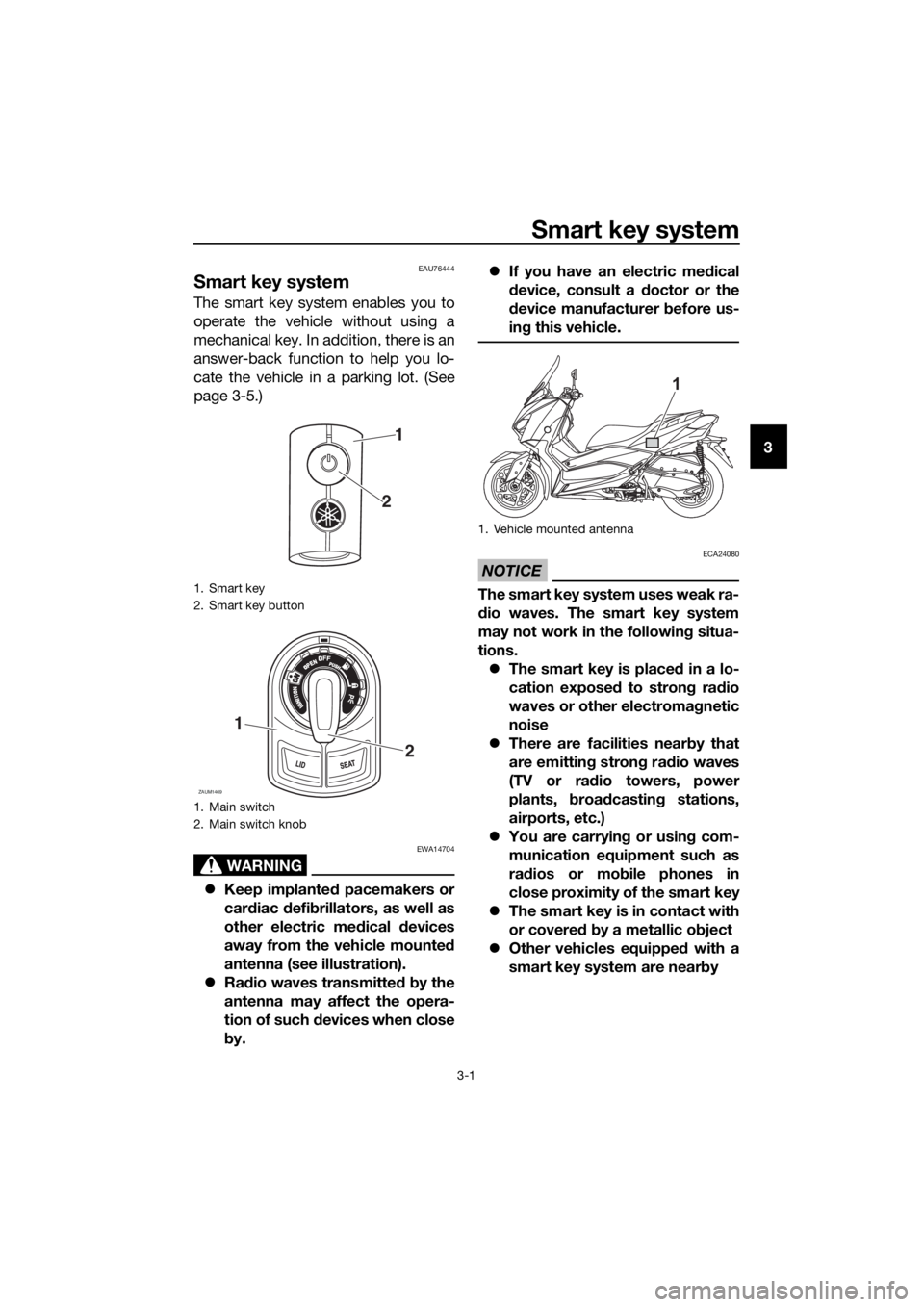
Smart key system
3-1
3
EAU76444
Smart key system
The smart key system enables you to
operate the vehicle without using a
mechanical key. In addition, there is an
answer-back function to help you lo-
cate the vehicle in a parking lot. (See
page 3-5.)
WARNING
EWA14704
Keep implanted pacemakers or
cardiac defibrillators, as well as
other electric medical devices
away from the vehicle mounted
antenna (see illustration).
Radio waves transmitted by the
antenna may affect the opera-
tion of such devices when close
by.If you have an electric medical
device, consult a doctor or the
device manufacturer before us-
ing this vehicle.
NOTICE
ECA24080
The smart key system uses weak ra-
dio waves. The smart key system
may not work in the following situa-
tions.
The smart key is placed in a lo-
cation exposed to strong radio
waves or other electromagnetic
noise
There are facilities nearby that
are emitting strong radio waves
(TV or radio towers, power
plants, broadcasting stations,
airports, etc.)
You are carrying or using com-
munication equipment such as
radios or mobile phones in
close proximity of the smart key
The smart key is in contact with
or covered by a metallic object
Other vehicles equipped with a
smart key system are nearby1. Smart key
2. Smart key button
1. Main switch
2. Main switch knob
1
2
ZAUM1469
2
1
1. Vehicle mounted antenna
1
UBY3E0E0.book Page 1 Friday, September 15, 2017 3:59 PM
Page 16 of 116
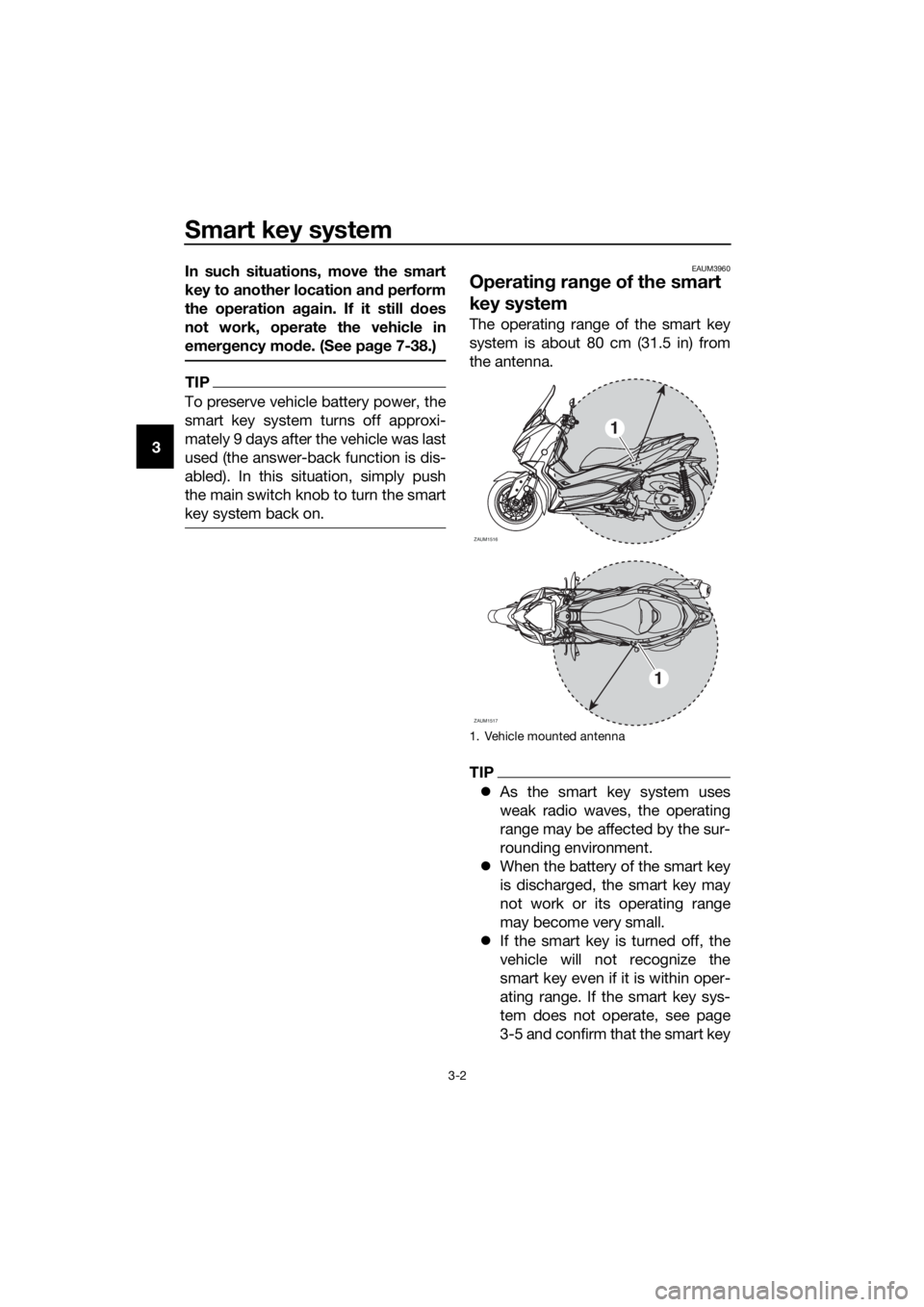
Smart key system
3-2
3In such situations, move the smart
key to another location and perform
the operation again. If it still does
not work, operate the vehicle in
emergency mode. (See page 7-38.)
TIP
To preserve vehicle battery power, the
smart key system turns off approxi-
mately 9 days after the vehicle was last
used (the answer-back function is dis-
abled). In this situation, simply push
the main switch knob to turn the smart
key system back on.
EAUM3960
Operating range of the smart
key system
The operating range of the smart key
system is about 80 cm (31.5 in) from
the antenna.
TIP
As the smart key system uses
weak radio waves, the operating
range may be affected by the sur-
rounding environment.
When the battery of the smart key
is discharged, the smart key may
not work or its operating range
may become very small.
If the smart key is turned off, the
vehicle will not recognize the
smart key even if it is within oper-
ating range. If the smart key sys-
tem does not operate, see page
3-5 and confirm that the smart key
1. Vehicle mounted antenna
ZAUM1516
1
ZAUM1517
1
UBY3E0E0.book Page 2 Friday, September 15, 2017 3:59 PM
Page 17 of 116
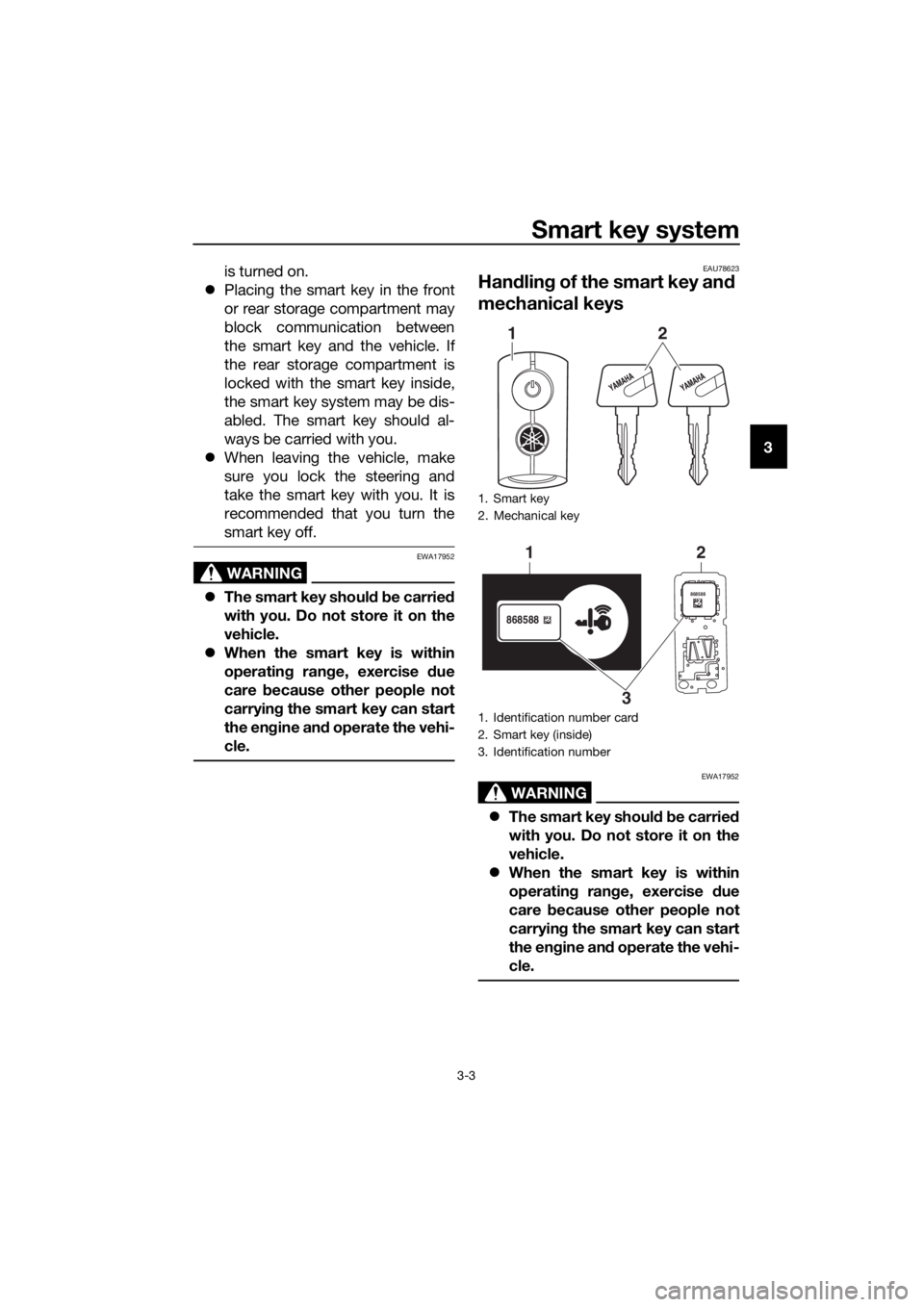
Smart key system
3-3
3 is turned on.
Placing the smart key in the front
or rear storage compartment may
block communication between
the smart key and the vehicle. If
the rear storage compartment is
locked with the smart key inside,
the smart key system may be dis-
abled. The smart key should al-
ways be carried with you.
When leaving the vehicle, make
sure you lock the steering and
take the smart key with you. It is
recommended that you turn the
smart key off.
WARNING
EWA17952
The smart key should be carried
with you. Do not store it on the
vehicle.
When the smart key is within
operating range, exercise due
care because other people not
carrying the smart key can start
the engine and operate the vehi-
cle.
EAU78623
Handling of the smart key and
mechanical keys
WARNING
EWA17952
The smart key should be carried
with you. Do not store it on the
vehicle.
When the smart key is within
operating range, exercise due
care because other people not
carrying the smart key can start
the engine and operate the vehi-
cle.
1. Smart key
2. Mechanical key
1. Identification number card
2. Smart key (inside)
3. Identification number
12
868588
868588
1
32
UBY3E0E0.book Page 3 Friday, September 15, 2017 3:59 PM
Page 18 of 116

Smart key system
3-4
3Included with the vehicle is one smart
key, two mechanical keys, and one
identification number card. The identi-
fication number can also be found on
the inside of the smart key itself.
If the vehicle battery is discharged, the
mechanical key can be used to open
the seat. Carry one mechanical key
in addition to the smart key.
If the smart key is lost or the smart key
battery has discharged, the identifica-
tion number can be used to operate
the vehicle in emergency mode. (See
page 7-38.) Write down the identifi-
cation number in case of emergen-
cy.
If the smart key is lost and the smart
key system identification number is un-
known, the entire smart key system will
need to be replaced at considerable
cost. Keep the identification number
card in a safe place.
NOTICE
ECA21573
The smart key has precision elec-
tronic components. Observe the fol-
lowing precautions to prevent
possible malfunction or damage.
Do not place or store the smart
key in a storage compartment.
The smart key may be damaged
from road vibrations or exces-
sive heat.
Do not drop, bend, or subject
the smart key to strong impacts.
Do not submerge the smart key
in water or other liquids.
Do not place heavy items or ex-
cessive stress on the smart key.Do not leave the smart key in a
place exposed to direct sun-
light, high temperature or high
humidity.
Do not grind or attempt to mod-
ify the smart key.
Keep the smart key away from
strong magnetic fields and
magnetic objects such as key
hold
ers, TVs, and computers.
Keep the smart key away from
electric medical equipment.
Do not allow oils, polishing
agents, fuel, or any strong
chemicals to come in contact
with the smart key. The smart
key body may become discol-
ored or cracked.
TIP
The smart key battery life is ap-
proximately two years, but this
may vary according to operating
conditions.
Replace the smart key battery
when the smart key system indi-
cator light flashes for 20 seconds
when the vehicle is turned on, or
when the smart key indicator light
does not come on when the smart
key button is pushed. (See page
3-6.) After changing the smart key
battery, if the smart key system
still does not operate, check the
vehicle battery and then have a
Yamaha dealer check the vehicle.
If the smart key continually re-
ceives radio waves, the smart key
battery will discharge quickly. (For
example, when placed in the vicin-
ity of electrical products such as
televisions, radios, or computers.)
UBY3E0E0.book Page 4 Friday, September 15, 2017 3:59 PM
Page 19 of 116
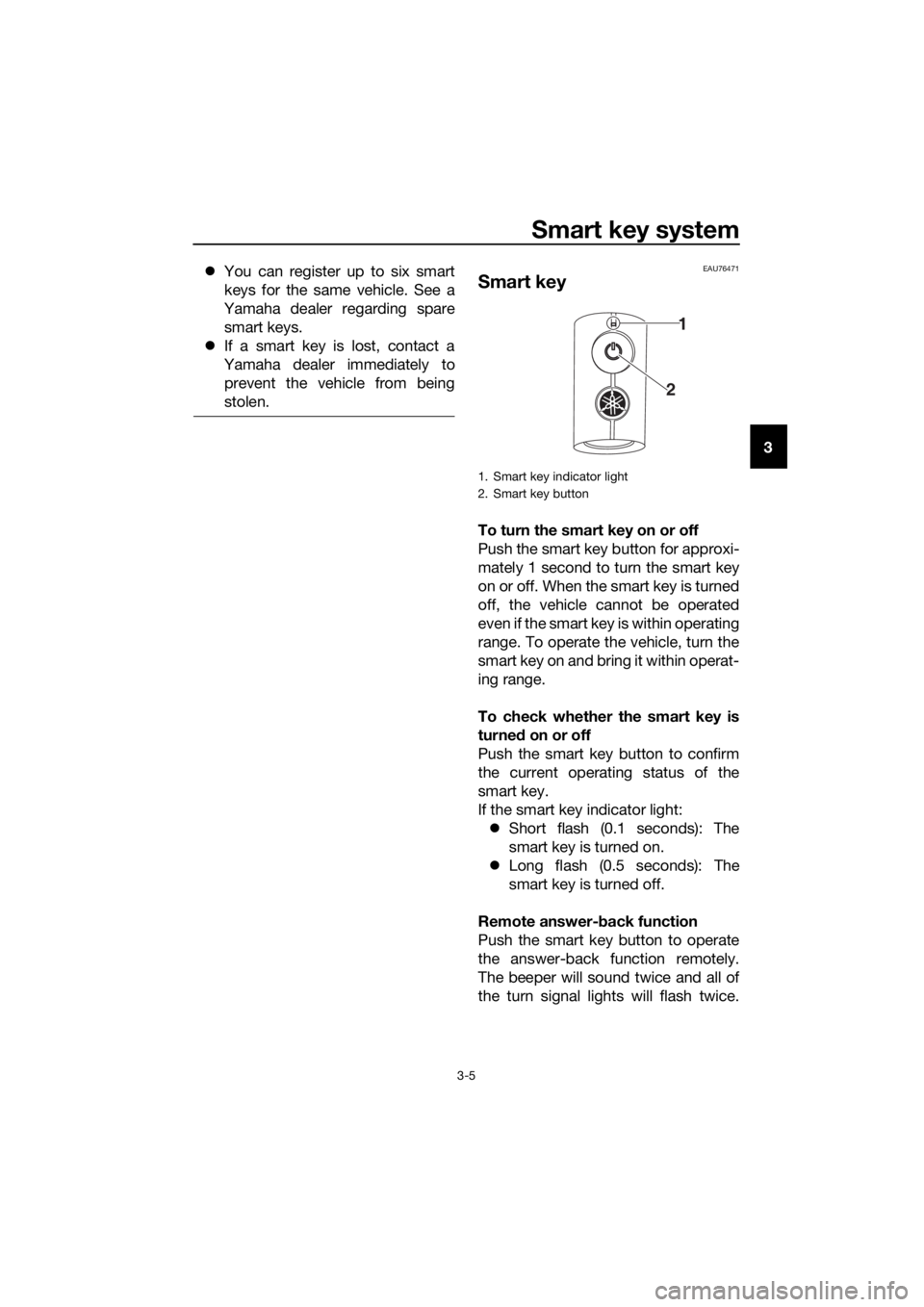
Smart key system
3-5
3 You can register up to six smart
keys for the same vehicle. See a
Yamaha dealer regarding spare
smart keys.
If a smart key is lost, contact a
Yamaha dealer immediately to
prevent the vehicle from being
stolen.
EAU76471
Smart key
To turn the smart key on or off
Push the smart key button for approxi-
mately 1 second to turn the smart key
on or off. When the smart key is turned
off, the vehicle cannot be operated
even if the smart key is within operating
range. To operate the vehicle, turn the
smart key on and bring it within operat-
ing range.
To check whether the smart key is
turned on or off
Push the smart key button to confirm
the current operating status of the
smart key.
If the smart key indicator light:
Short flash (0.1 seconds): The
smart key is turned on.
Long flash (0.5 seconds): The
smart key is turned off.
Remote answer-back function
Push the smart key button to operate
the answer-back function remotely.
The beeper will sound twice and all of
the turn signal lights will flash twice.
1. Smart key indicator light
2. Smart key button
1
2
UBY3E0E0.book Page 5 Friday, September 15, 2017 3:59 PM
Page 20 of 116
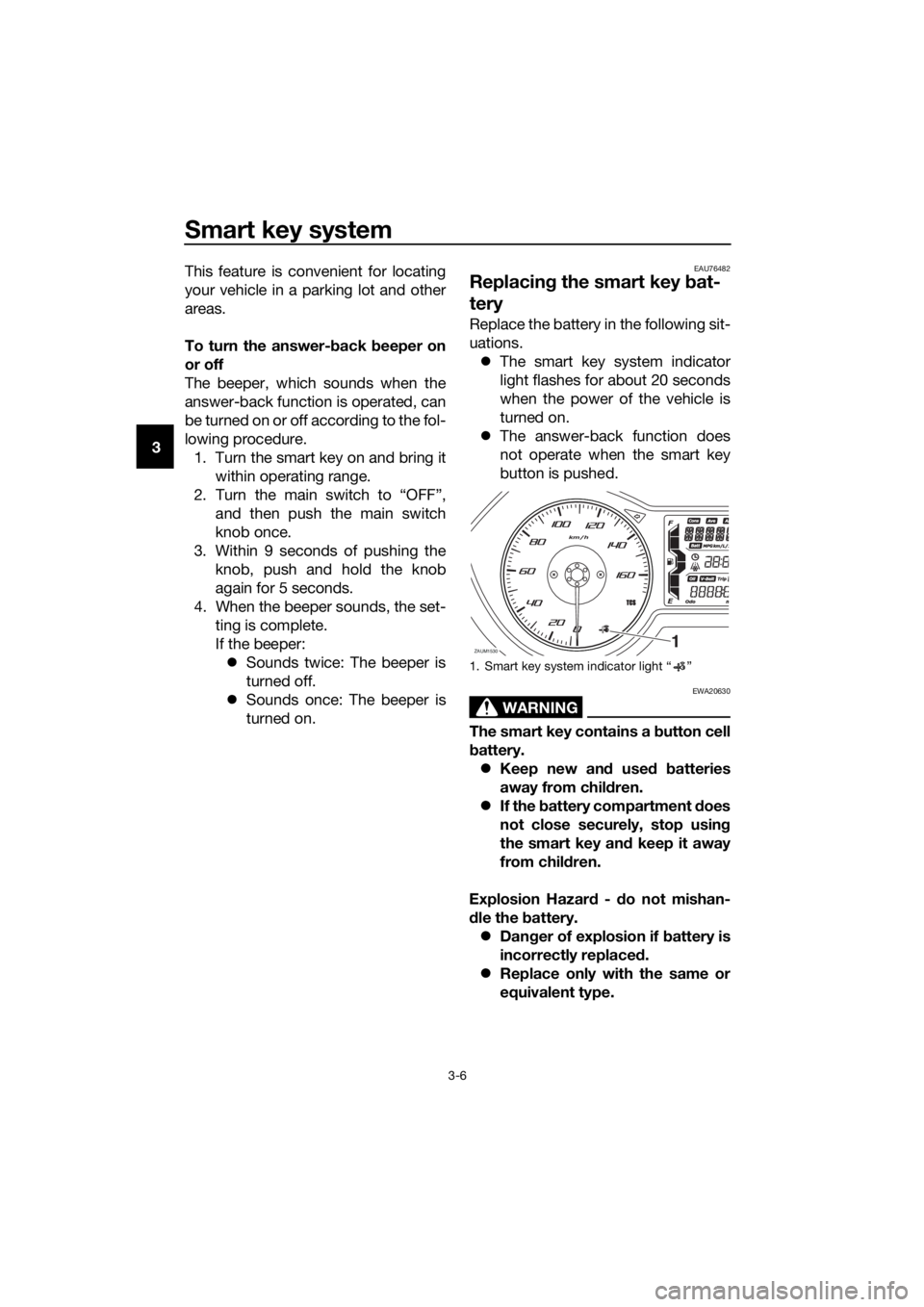
Smart key system
3-6
3This feature is convenient for locating
your vehicle in a parking lot and other
areas.
To turn the answer-back beeper on
or off
The beeper, which sounds when the
answer-back function is operated, can
be turned on or off according to the fol-
lowing procedure.
1. Turn the smart key on and bring it
within operating range.
2. Turn the main switch to “OFF”,
and then push the main switch
knob once.
3. Within 9 seconds of pushing the
knob, push and hold the knob
again for 5 seconds.
4. When the beeper sounds, the set-
ting is complete.
If the beeper:
Sounds twice: The beeper is
turned off.
Sounds once: The beeper is
turned on.
EAU76482
Replacing the smart key bat-
tery
Replace the battery in the following sit-
uations.
The smart key system indicator
light flashes for about 20 seconds
when the power of the vehicle is
turned on.
The answer-back function does
not operate when the smart key
button is pushed.
WARNING
EWA20630
The smart key contains a button cell
battery.
Keep new and used batteries
away from children.
If the battery compartment does
not close securely, stop using
the smart key and keep it away
from children.
Explosion Hazard - do not mishan-
dle the battery.
Danger of explosion if battery is
incorrectly replaced.
Replace only with the same or
equivalent type.
1. Smart key system indicator light “ ”
ZAUM15301
UBY3E0E0.book Page 6 Friday, September 15, 2017 3:59 PM